| . .
.
.
.
.
.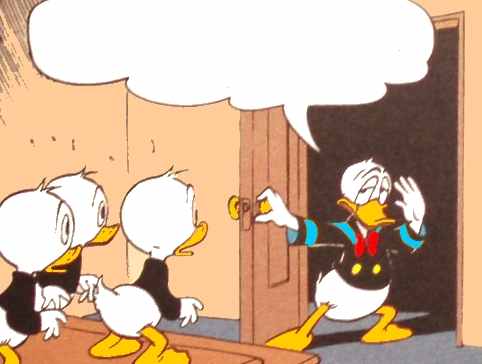
WDCS131
'The Unlucky Golfer'
.
.
.
.
.
.
.
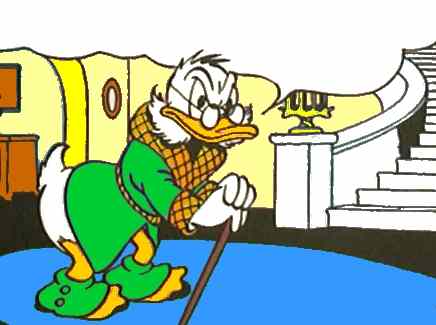
FC0178
Christmas on Bear Mountain
.
.
.
.
.
.
.
.
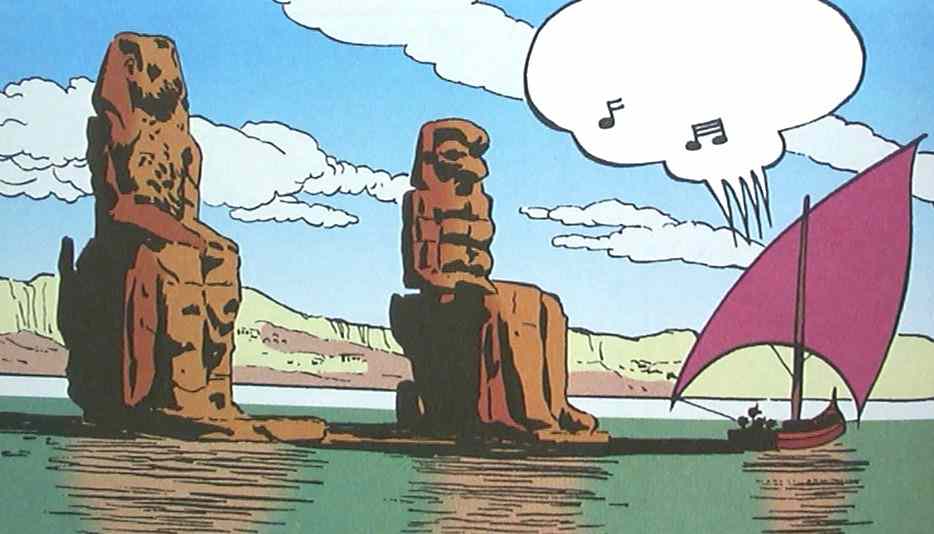
FC0029
The Mummy's Ring
.
.
.
.
.
.
.
.
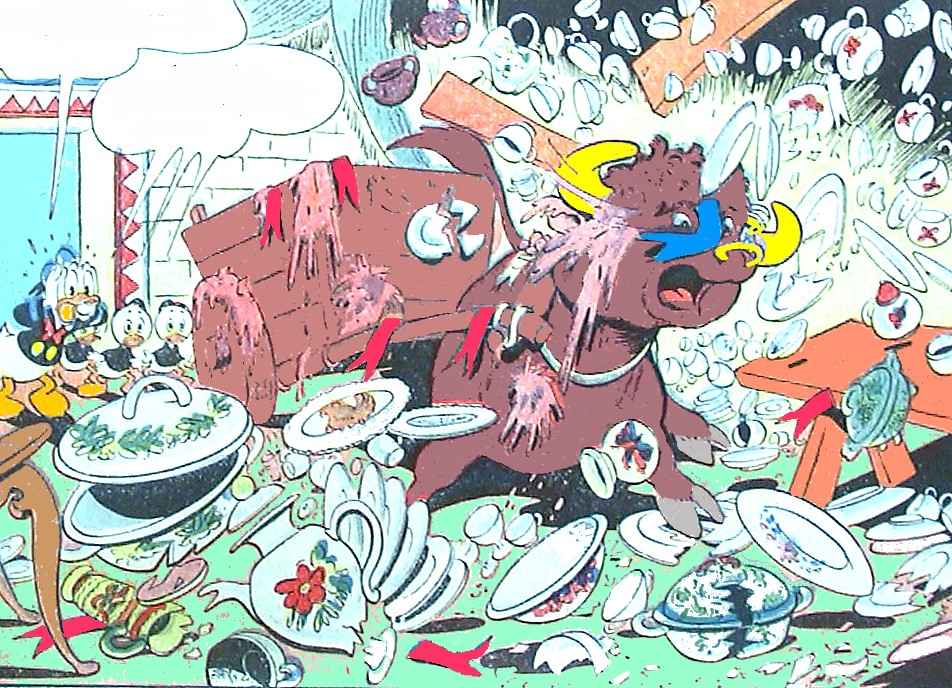
WDCS182
'The Raging Bull'
.
.
.
.
.
.
.
.
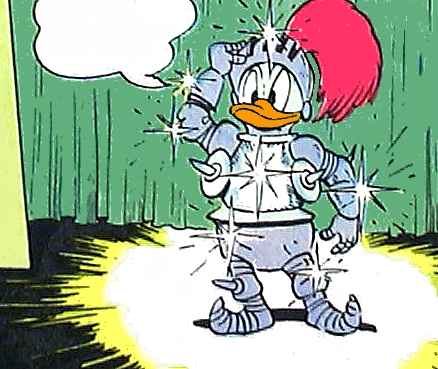
WDCS198
'Hero of the Ball'
|
|
I was never able to just sit
down and write a longhand script. First, I jotted
down a bunch of gags that would come to my mind.
Then I would start hooking the gags together, and
pretty soon I'd have a sort of a little synopsis.
From that, I'd break it down into a longer
synopsis. Make a mark every two or three lines
and think, 'Well, that will make one page', and 'This'll
make another page'. By the time I'd get to the
bottom of my synopsis, I'd know whether I was
going to have enough material.
Any time that I wrote a script,
when I got through with it, I'd lay it aside,
pick it up the next morning, and read it. If it
didn't read with a lot of rhythm going right on
through, I'd work on it another day or so until I
got to where it sounded good, then start drawing.
With the drawing, too, I would pick up sheets
that I had done two or three days before and look
at them. If the business didn't look right, I
didn't mind doing it over. I was after a certain
quality.
I was letting the story build up
to a certain point in which the reader would be
expecting the conventional end, and then I would
fool the reader by dragging in something that was
completely ridiculous, making it look plausible.
Example: Donald's unexpected 'retirement' to the
privacy of his closet after a turmoilish day in WDCS131
'The Unlucky Golfer'.
The choice of words also was one of
Barks' passions: I'll rather use one word
instead of four, he once stated, and
consequently he polished and re-polished his
material to perfection. I tried to make it as
brief as possible. If I could find a word that
would express what four words say, I would use
that one word. So I had a sort of short, very
crisp dialogue in my stories as a result of that
contracting them down. And, in order to get the
dialogue as short as possible, sometimes it was
necessary to even count the syllables, and I
would do that if it got down to it, and that also
helped to create an even flow, so that it was
almost like prose poetry the way the ducks voices
would come in.
I tried to end each page,
especially toward the latter part of the story,
with a little zinger that would carry the reader
forward. Sometimes the story would not lend
itself to that kind of presentation, but that's
the way we learned it at the Disney Studios
working on the short subjects. There had to be a
little climax just about every few seconds on the
screen, so that's the way I tried to write the
duck stories.
I bought a large bulletin board,
and when I'd get a half sheet or a comic page
done in pencil, I'd stick it up there, and then
the next one, and the next one, and after I got
about five of them done, I would sit back and
look at the display and read the continuity.
Sometimes I would take down two or three sheets
and do a lot of erasing and changing. I was able
to visualize my story progress much better that
way.
Later, I finally got so polished at writing those
stories that I didn't need to work by that method.
I could just do a half page and stick it up on
the shelf. I was able to visualize it more or
less from my longhand, rather than having to have
it up there in pencil drawings. But I think that
my best work was done back in those years, when I
had, say, five pages all laid out in blue pencil
to criticize.
On inventing new characters:
There were definite reasons for it. When I
had used Donald and his three nephews several
times in a row, for example, I'd always think one
ought to do something else, make up new gags, and
at some point the idea came to me that one could
also introduce new characters for this purpose. I
introduced Gladstone Gander, for example,
originally as a foil for Donald, a rival, who in
his first story (WDCS088 'Cocky
Combattants' - Editor's remark) concerning
a bet, was just as dumb as Donald. He only later
developed into such a lucky duck.
As for Scrooge McDuck, he just appeared as a
grumpy uncle and had something to do with Donald,
because the story required it (FC0178
Christmas on Bear Mountain - Editor's
remark). But the more I used him, the more
strongly I realized that one can't always draw a
character in a bad light, any more than one can
show the same character as having exclusively
good qualities. That just gets boring.
Scrooge was created more by chance, in contrast
to Magica de Spell, about whom I had more of an
idea that here was a new, regular figure to be
used. Magica was introduced much more
intentionally, as a wicked witch who was always
after Scrooge's first-earned dime (U$36
The Midas Touch - Editor's remark).
I thought at the time: Disney's always had
witches who were ugly and repulsive, so why
shouldn't I draw one that's not ugly, but
outright sexy? That's why she is Italian...
You've got to be darn sure that
your idea is presented. If it's going to take
three or four drawings to present that idea, the
timing of it comes in on how much development you
do in the first panel, how much you do in the
second, how much in the third, and if you keep
the development just enough that the reader can
figure out what is coming, and then in the fourth
panel, give it to him with a big sock right in
the face. That's what I consider timing.
I don't know exactly why I did
so much research for my stories, but I had the
feeling the ducks had to go to real places.
Otherwise the stories would look silly. I know in
the other duck stories in the comics they went to
islands like Booga Booga or something like that,
places that didn't have any relation to reality.
And they made their drawings in little squiggly
backgrounds that didn't have the right character,
for example the South Seas.
When I sent the ducks to an island in the South
Seas, I gave it a name that sounded very much
like it could actually be on the map. And I would
go and look at pictures of plants there, and
islands and mountains, and all the rest, and I
made my background look like the ducks went to
just such a place (Barks primarily used
National Geographic and Encyclopedia Britannica
as his sources - Editor's remark). Example: The
Ducks pass by the Colossal of Memnon on the Nile
in FC0029 The Mummy's Ring.
Ideas generally come in a very
complicated form, and you've got to strip them
down to make them useable. Boil a gag down to its
simplest form and it is readily discernible to
anybody who sees it.
Don't try to use too many ideas
in a story plot. You have to be selective. Be
mean. Throw perfectly lovely gags in the waste
basket.
My stories are timeless. They
can be read again and again and are still good
years later. I always tried for that, just as I
always tried to keep the stories as international
as possible. That's why I, as far as I could,
avoided particular American things like baseball,
because I hardly think that you, in Germany,
would understand a baseball story.
I always tried to write a story
in such a manner that I wouldn't mind buying it
myself. I know that I was expected to write for
an audience of 12-year olds. But my faith in the
12-year old's intelligence was greater than the
publisher's. In my opinion the kids should have
relevant experience for their 10-cent.
When struggling for a story, I
would often ask myself: what locale do I want to
draw? Do I want to draw a forest, the sea with
sailboats, or would it be down in the mines and
caves? As soon as I thought of a locale, I could
come up with a reason for putting characters in
that locale.
I took a piece of paper and drew
a few funny situations on it, just ideas that I
had. What should I have the ducks do today? When
I had enough individual gags, I'd make a short
summary and develop the entire story, as a whole.
That was one difference between me and the other
artists and writers. I took individual gags,
tightened them up and built the highpoint of the
story out of them, and then I went back - how
could the ducks get into such a situation, or
more concretely: Why did the bull smash the china,
how did he get there (plot idea from WDCS182
'The Raging Bull' - Editor's remark)?
I always proceeded very logically, and the
individual logical steps were made as funny as
possible.
Once in a while the little kids
would get themselves in some pretty bad messes
and then Donald would have a chance to rescue
them. But mostly it was Donald who got clobbered
and the kids who rescued him. It worked out
better, and it appealed to more people that way,
because the readers were kids themselves. They
liked to feel a little bit superior to the uncle
who was strutting around.
In fact I laid it right on the
line. There was no difference between my
characters and the life my readers were going to
have to face. When the Ducks went out in the
desert, so did Joe Blow down the street with his
kids. When Donald got buffeted around, I tried to
put it over in such a way that kids would see it
could happen to them. Unlike the superhero comics,
my comics had parallels in human experience.
I often liked to put the ducks
into situations where they could be at sea. There
is something romantic about harbors and sunken
ships that appeals to all kids.
There have been times when I
felt nervous about taking a chance with a plot,
but it wasn't enough to stop me. I'd compromise a
bit if I felt I was getting too wild. I've
approached every subject with my teeth chattering
and knees knocking. Getting new ideas was the big
nerve-racker. Often I'd feel I'd pumped the well
dry and hadn't another idea in my system - I'd
get real scared. I can remember times when I got
so scared that when I did come up with an idea, I
almost cried with relief at having gotten over
that hump again.
Of all the 500 stories I wrote,
there was about 10 of them that started with
suggestions from someone else. Example:
Barks' daughter Peggy suggested the plot for WDCS198
'Hero of the Ball'.
I was letting the story build up
to a certain point in which the reader would be
expecting the conventional end, and then I would
fool the reader by dragging in something that was
completely ridiculous, making it look plausible.
Writing was a mental strain.
Once I had gotten the general idea, then that was
a moment of joy ... It wasn't genius or even
unusual talent that made the stories good, it was
patience and a large waste basket.
|

